Elizabeth Culotta
Science 18 May 2012: Vol. 336, Issue 6083, pp. 825-827 DOI: 10.1126/science.336.6083.825
Humans everywhere divide the world into “us” and “them.” Why are we so tribal?
You're alone in a dark alley late at night. Suddenly a man emerges from a doorway. If you are a typical white American and he is a young black man, within a few tenths of a second you will feel a frisson of fear as your brain automatically categorizes him. Your heart beats faster and your body tenses.
In this event, nothing happens. He glances at you and moves away. You walk on, feeling foolish for fears based merely on his membership in a racial group.
Tension and suspicion between groups—whether based on racial, ethnic, religious, or some other difference—fuel much of the world's violence. From the enduring feuds of the Middle East and Northern Ireland, to the vicious raids of South Sudan, to the gang warfare that plagues American cities, even to bullying in schools and skirmishes between fans of rival sports teams, much of the conflict we see today erupts because “we” are pitted against “them.”
Some of the prejudice behind these conflicts is not conscious: Your fear spiked in that dark alley before your conscious brain had even registered the young man's skin color. This prejudice apparently stems from deep evolutionary roots and a universal tendency to form coalitions and favor our own side. And yet what makes a “group” is mercurial: In experiments, people easily form coalitions based on meaningless traits such as preferring one painter over another—and then favor others in their “group,” giving them more money in games, for example. “In arbitrarily constructed, meaningless groups with no history, people still think that those in their ingroup are smarter, better, more moral, and more just than members of outgroups,” says Harvard University psychologist James Sidanius.
A wide and deep literature has explored these innate biases in the 40 or so years since they were first discussed. Now researchers have begun to ask why humans are apparently primed to see the world as ingroups and outgroups. What factors in our evolutionary past have shaped our coalitionary present—and what, if anything, can we do about it now?
Several avenues of research are probing the origins of what many psychologists call ingroup love and outgroup hate. Researchers are testing the implicit biases of young children and even primates, and devising experiments to ratchet bias up and down. Evolutionary researchers are trying to parse the group environments of our ancestors and are debating just how big a selective pressure came from outgroup male warriors. “The origin of all this is the all-consuming question of the past few years,” says Harvard psychologist Mahzarin Banaji.
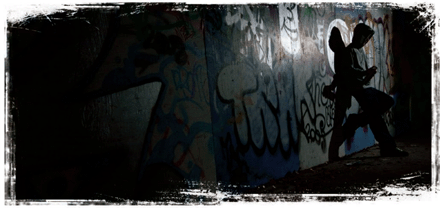
Group Love
Fear of “them.” Members of outgroups can spark automatic, implicit prejudice. Credity: © Justin Minns/ALAMY
For many researchers, our cruelty to “them” starts with our kindness to “us.” Humans are the only animal that cooperates so extensively with nonkin, and researchers say that, like big brains, group life is a quintessential human adaptation. (In fact, many think big brains evolved in part to cope with group living.) Studies of living hunter-gatherers, who may represent the lifestyle of our ancestors, support this idea. Hunter-gatherers “cooperate massively in the flow of every imaginable good and service you can think of,” says anthropologist Kim Hill of Arizona State University (ASU), Tempe, who has studied hunter-gatherers for 35 years. “Anything you need in daily life, the person next to you will lend you: water, sticks for firewood, a bow and arrow, a carrying basket—anything.”
Thus the group buffers the individual against the environment. “Our central adaptation is to group living,” says psychologist Marilynn Brewer of the University of New South Wales in Sydney, Australia. “The group is primary.”
When the ingroup is loved, by definition there must be a less privileged outgroup. “One can be expected to be treated more nicely by ingroup members than by outgroups,” as Brewer put it in a seminal 1999 paper. “It is in a sense universally true that ‘we’ are more peaceful, trustworthy, friendly, and honest than ‘they,’” she wrote.
If groups compete for territory or resources, favoring the ingroup necessarily means beating the outgroup and can escalate into hostility, Brewer notes. Several other researchers (see p. 876) have recently argued the reverse: that over time, hostilities between groups fostered ingroup love, because more cooperative groups won battles. Whichever came first, researchers agree that outgroup hate and ingroup love may have spurred each other.
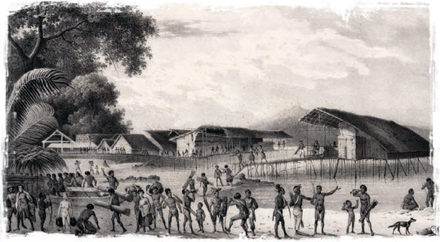
Credit: SSPL via Getty Images
A warrior past? Battles among hunter-gatherers such as these Papua New Guineans suggest to some that ancient wars shape modern fears.
In the United States and some other countries, the sharpest division between groups is often racial. But researchers agree that it's not that white people have evolved to be suspicious of black people per se or vice versa. Such an evolved prejudice could only arise as the result of frequent negative interactions between races in the past, explains anthropologist Robert Boyd of the University of California, Los Angeles. But thousands of years ago, people didn't cross continents to meet each other. “In the distant past, we had very little experience interacting with people who were physically very different from us,” Boyd says. “That's only since 1492. Ethnic distinctions, however, are presumably quite old.” Thus racial prejudice is a subset of a much broader phenomenon. “This is not just about racism,” says psychologist Susan Fiske of Princeton University.
The targets of outgroup prejudice vary from culture to culture and over time—Sidanius refers to them as “arbitrary set” prejudices. In Sri Lanka, it may be Tamils; in Northern Ireland, Catholics or Protestants; in India, the Untouchables. Fiske notes that the world over, the greatest prejudice is often aimed at people without an address, such as gypsies and the homeless. Whoever the target, we have a psychological system that prepares us to “learn quickly, in whatever cultural context we're in, what are the cues that discriminate between us and them,” says psychologist Mark Schaller of the University of British Columbia, Vancouver, in Canada.
This doesn't mean that prejudicial behavior is inevitable, Schaller says. “These prejudices tap into very ancient parts of our minds, and it's happening at a very quick, automatic level,” he says. “But we have recently evolved parts of our brains that allow us to engage in slower, more rational thought. When I experience that fear in a dark alley, it may take me another half-second for a more rational thought to kick in, but I'll get there, if I have the motivation and means to do so.”
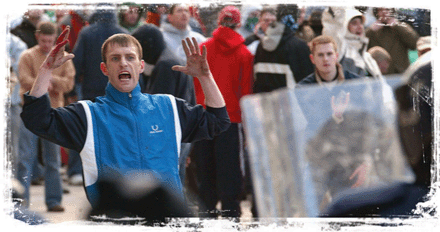
Credit: Stringer Ireland/Reuters
Religion, not race. Groups divide along many axes, including religion, as when protesters and police clash in Northern Ireland.
Shoot or Don't Shoot
Psychologists have become master manipulators of prejudice in the lab, with clever experiments that reveal underlying biases. In the Implicit Associations Test, for example, people are asked to rapidly categorize objects and faces; the pattern of mistakes and speed shows that people more quickly associate negative words such as “hatred” with outgroup faces than ingroup faces. “It takes significantly longer to associate your ingroup with bad things and the outgroup with good things,” Sidanius says. In disturbing tests using a video game, people looking at a picture of a person carrying an ambiguous object are more likely to mistake a cell phone for a gun and shoot the carrier if he is an outgroup male.
This type of bias shows up in all cultures studied and in children; it also appears in people who say they are not prejudiced and who work consciously for equality. “This is in every single one of us, including me,” Banaji says.
It starts young. In work in review, Yarrow Dunham of Princeton, Banaji, and colleagues found that Taiwanese toddlers assumed that a smiling racially ambiguous face was Taiwanese, but a frowning one was white; white, American 3-year-olds similarly preferred their ingroup.
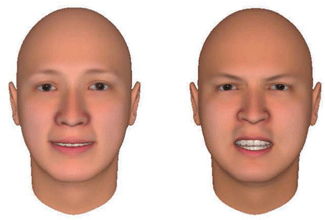
Credit: Yarrow Dunham
Whose group? Taiwanese toddlers thought racially ambiguous faces like these were Taiwanese when smiling and white when looking angry.
Even our primate cousins categorize others into ingroups and outgroups. Chimps obviously have outgroup bias: They sometimes band together and attack and kill members of other troops. Last year, a study managed to uncover primates' implicit expectations of “us” and “them” for the first time.
Laurie Santos of Yale University, working with Banaji and others, adapted a psychological test for rhesus macaques, group-living monkeys whose lineage diverged from ours about 25 million to 30 million years ago. The researchers assumed that the macaques would stare longer at outgroup faces, who might be more dangerous, or at groups of photos that paired things they liked with outgroup faces they didn't like. In a series of experiments published in the Journal of Personality and Social Psychology, Santos and colleagues found that macaques looked longer at photos of outgroup members. They also looked longer at photos of outgroup members next to pictures of fruit, and at photos of ingroup members with spiders and snakes.
Seeing such apparent bias in primates suggests it is evolutionarily ancient. This “coherence of results across species and ages is satisfying,” Banaji says, and tells us that outgroup bias is “core to our species.”
While these researchers probe bias in different populations, others are exploring how to manipulate it. Our attitudes toward outgroups are part of a threat-detection system that allows us to rapidly determine friend from foe, says psychologist Steven Neuberg of ASU Tempe. The problem, he says, is that like smoke detectors, the system is designed to give many false alarms rather than miss a true threat. So outgroup faces alarm us even when there is no danger.
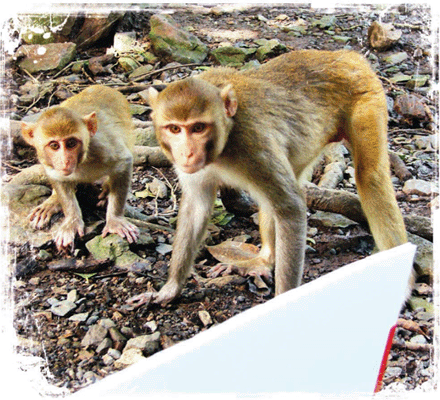
Credit: Laurie Santos
On the lookout. Macaques stared longer at photos of the faces of outgroup members than at ingroup faces.
Neuberg and Schaller have studied what might turn this detection system up and down. When you feel threatened, you react to danger more quickly and intensely; people startle more easily in the dark. That's why prejudice rears its head in a dark alley rather than a well-lit field. In a variety of studies, Neuberg, Schaller, and their colleagues have manipulated people into feeling unconsciously more fearful or confident and found that measures of outgroup bias respond. Canadians taking tests in the dark rated Iraqis as less trustworthy and more hostile than other Canadians. Sinhalese in Sri Lanka stereotyped Tamils as more hostile after being primed with a geographic context that made them feel outnumbered. And white undergraduates were more likely to misperceive anger on the faces of black men—but not whites—after watching a scary scene from the movie The Silence of the Lambs. Schaller adds that some people seem to go through life more cognizant of threats than others, and that prejudice is more easily intensified in these people.
These findings can inform real-life tragedy, researchers say. On the evening of 26 February, a Hispanic man named George Zimmerman shot an unarmed black teenager, Trayvon Martin, in a gated community in Sanford, Florida. Zimmerman told police that he followed Martin suspecting criminal activity, was attacked, and fired in self-defense. Researchers cannot speak to what happened that night. But when Zimmerman first spotted Martin, the situation was a “perfect storm” for triggering feelings of vulnerability and implicit prejudice, Neuberg and Schaller say.
It was dark and raining. Martin, 17, though slender, was tall. Zimmerman, 28, was quite alert to crime in his neighborhood; he had started the neighborhood watch. Martin was young, male, and black, an outgroup stereotyped as dangerous by whites and Hispanics in the United States. “We would predict that under those circumstances this kind of thing would happen more often,” Neuberg says.
If certain situations turn implicit prejudice up, can it be turned down? Schaller notes that making people feel safer can moderate this bias, whether through specific priming or more generally with lower crime rates or a better economy. To unconsciously prime her own mind, Banaji has created a screen saver that displays stereotype-smashing images. Other researchers say that deliberately engaging the slower conscious mind may help. For example, in addition to skimming all job applications quickly, a manager might read the files of minority applicants with care.
Men in the crosshairs
Martin is a good example of how outgroup prejudice falls hardest on men, Sidanius says. He argues that this has specific evolutionary roots: Because it is men who typically make war, it was outgroup men who attacked our ancestors; it was also men who were more likely to be killed in combat. “Back in the Pleistocene, outgroup males really were dangerous,” he says.
If natural selection has shaped our minds to be wary of outgroup males, then they should face more prejudice than outgroup women, says Sidanius, an African American who himself was the target of hate crimes as a young man. He and colleagues have assembled a devastating catalog showing how this is true for black men in America. As compared with black women, black men are more likely to be victims of hate crimes, receive harsher jail sentences for comparable offenses, pay more money for cars—the list goes on and on. Data suggest that West Indian and South Asian men in the United Kingdom face similarly disproportionate bias, Sidanius says.
Building on these ideas, in March, Melissa McDonald of Michigan State University in East Lansing and colleagues proposed what they called the “warrior male hypothesis,” arguing that natural selection has shaped men's minds, more than women's, toward belonging to coalitions. They predict that men are more prejudiced than women, and some data show this.
But others aren't so sure that intergroup war was a prominent feature of our prehistory (see p. 829). Foragers depend on farflung networks to gain access to the social and natural resources of others, notes anthropologist Polly Wiessner of the University of Utah in Salt Lake City. The !Kung of Africa, whom Wiessner studied for decades, “may travel for hundreds of miles to visit exchange partners in less familiar areas, with no fear of unknown males,” she says.
Whether or not humans have evolved to fear outgroup men per se, researchers agree that we are prone to categorize and sometimes fear outgroups. “What we're arguing is a natural preference for drawing ingroup-outgroup boundaries. It can be race, religion, nationality, dialect, or arbitrary set differences,” Sidanius says. “But once those boundaries are drawn, people like to discriminate across them.”
Science: 336 (6083)
Vol 336, Issue 6083
18 May 2012
See other sources at:
